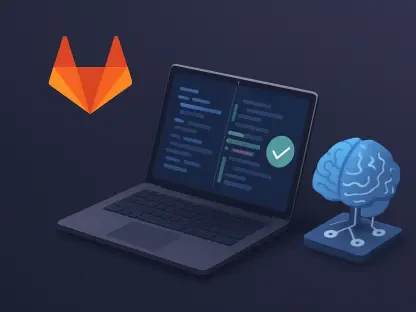The Rising Challenge of AI Crawlers in the Digital Landscape
In an era where digital content is both a valuable asset and a vulnerable target, the proliferation of AI-driven web crawlers has emerged as a significant threat, with studies estimating that over 40% of internet traffic now stems from automated bots. These sophisticated tools, often deployed by tech giants for data harvesting, are scraping websites at an unprecedented scale, challenging the very foundations of content security and site performance. This surge in bot activity not only strains server resources but also risks the unauthorized use of intellectual property, placing website owners in a precarious position.
The need to safeguard online content has never been more critical, as traditional defenses like simple robots.txt files are frequently bypassed by advanced AI scrapers that ignore established web protocols. Industries such as e-commerce, publishing, and media are particularly vulnerable, where data theft can lead to competitive disadvantages or loss of revenue. Key players in this space include AI innovators like OpenAI and Anthropic, whose crawlers fuel large language models, alongside defensive solution providers such as Cloudflare and DataDome, which are stepping up to offer robust protection mechanisms.
This issue spans multiple sectors, with e-commerce platforms facing pricing data theft and publishers grappling with content duplication. The scope of the problem underscores a pressing industry-wide concern: how to block unwanted bots without disrupting legitimate traffic. As AI crawlers evolve, the digital landscape demands innovative strategies that go beyond outdated methods to ensure both security and accessibility remain intact.
Current Trends and Market Insights in Web Protection
Emerging Strategies and Technologies
A notable shift is underway in web protection, moving away from JavaScript-based defenses toward server-side techniques that operate invisibly to users. Methods such as HTTP header manipulation, enhanced robots.txt configurations, and IP-based filtering are gaining traction as effective ways to deter unauthorized crawlers. These approaches minimize impact on site performance and maintain compatibility with search engine requirements, ensuring legitimate bots like Googlebot can still index content.
Beyond technical barriers, there’s a growing adoption of hybrid strategies that combine server-side solutions with legal frameworks. Terms of service that explicitly prohibit scraping, paired with cease-and-desist actions, are becoming common tools to combat persistent violators. This dual approach reflects an industry realization that technology alone cannot fully address the sophisticated tactics employed by modern scrapers.
Community-driven insights also play a pivotal role, with platforms like X serving as hubs for sharing accessible defense mechanisms. Subtle tactics, such as serving irrelevant or low-quality content to suspected bots, are emerging as clever ways to frustrate scrapers without direct confrontation. These methods highlight a trend toward creativity in defense, focusing on disruption rather than outright blocking to protect valuable data.
Market Dynamics and Future Outlook
Analysis of current data reveals the diminishing effectiveness of traditional tools like robots.txt against AI-driven scrapers, with reports indicating that many bots simply ignore these directives. This has fueled a surge in demand for SEO-friendly solutions that can block malicious crawlers while preserving access for legitimate users and search engines. The market is responding with innovations that prioritize balance, ensuring websites remain visible and functional for their intended audiences.
Looking ahead, projections suggest continued growth in server-side defenses and machine learning-based detection systems, driven by the need to counter evolving scraper tactics. From 2025 to 2027, experts anticipate a significant uptick in adaptive technologies that can dynamically respond to bot behavior. This forward momentum is supported by industry publications emphasizing non-JavaScript methods as the cornerstone of future crawler defense strategies.
Market consensus points to a sustained focus on subtle and effective protection mechanisms that do not rely on client-side scripts, which can hinder SEO performance. The emphasis on server-side innovation reflects a broader understanding that as AI scraping tools become more advanced, defensive measures must evolve in tandem to maintain a competitive edge in web security.
Challenges in Blocking AI Crawlers Effectively
Identifying and blocking sophisticated bots presents significant technological hurdles, especially as many employ proxy rotation and CAPTCHA-solving capabilities to evade detection. These tactics make it difficult to distinguish between malicious crawlers and legitimate traffic, complicating efforts to implement effective barriers. The complexity of this task often requires substantial resources and expertise, posing a challenge for smaller website operators.
Another critical issue is the risk of overblocking, which can inadvertently harm SEO rankings or alienate genuine users and search engines. A heavy-handed approach might deter bots but could also block beneficial crawlers like Googlebot, leading to reduced visibility in search results. Striking the right balance remains a persistent struggle for many in the industry, as the consequences of missteps can be costly.
Potential solutions to these challenges include advanced traffic pattern monitoring and selective filtering to target suspicious behavior without broad restrictions. Additionally, integrating friction-based tactics, such as delayed responses to suspected bots, can discourage scraping without impacting human users. These adaptive measures highlight the ongoing cat-and-mouse game between scrapers and defenders, necessitating constant vigilance and investment in updated strategies.
Legal and Ethical Considerations in Crawler Defense
The regulatory landscape surrounding web scraping is complex, with terms of service often serving as legal deterrents against unauthorized data harvesting. Many website owners are leveraging these agreements, alongside formal cease-and-desist letters, to reinforce their technical defenses. Such legal tools provide a framework for addressing violations, particularly when dealing with large-scale AI scraping operations.
Ethical concerns also loom large, as indiscriminate blocking risks undermining accessibility for legitimate users and search engines. The industry is increasingly aware of the need to design defenses that do not penalize valid traffic, ensuring that protection measures align with broader web accessibility principles. This balance is essential to maintain trust and usability in the digital ecosystem.
Legal strategies are shaping industry practices, with notable case studies demonstrating their impact on curbing scraping activities. However, compliance must be balanced with innovation to ensure that defenses remain effective without compromising SEO best practices or user expectations. This intersection of law and technology underscores the multifaceted approach required to address AI crawler challenges responsibly.
The Future of Web Protection Against AI Crawlers
Emerging technologies are poised to redefine web protection, with advanced machine learning for bot detection and adaptive server configurations showing significant promise. These innovations aim to anticipate and counteract scraper behavior in real time, offering a proactive rather than reactive stance. As these tools mature, they are expected to become integral to safeguarding online content.
Market disruptors, such as new evasion tactics by scrapers, will likely spur further advancements from defensive tool providers. The response to these challenges may include novel approaches to traffic analysis and bot identification, ensuring that protection keeps pace with threats. Global trends, including consumer demand for privacy and shifting economic conditions, will also influence the trajectory of web security solutions.
Continuous innovation remains paramount, as the industry must stay ahead of AI-driven threats while maintaining a user-friendly and SEO-compatible environment. The interplay of technological progress and societal priorities will shape how website owners protect their digital assets, emphasizing resilience and adaptability in an ever-changing landscape.
Conclusion and Strategic Recommendations
Reflecting on the insights gathered, it is evident that non-JavaScript, server-side defenses stand out as a powerful means to block AI crawlers effectively. The exploration of various strategies revealed a clear path for website owners to integrate technical solutions with legal and community-driven approaches, forming a comprehensive shield against digital threats. This balanced framework proved essential in addressing the multifaceted nature of web scraping.
Moving forward, a key recommendation is to adopt adaptive methods like selective filtering, which target malicious bots while preserving access for legitimate traffic. Website owners are encouraged to explore friction-based tactics and machine learning tools to stay ahead of evolving scraper techniques. These actionable steps offer a way to enhance protection without sacrificing site performance or visibility.
Ultimately, the journey toward robust web security demands a commitment to ethical blocking practices and ongoing innovation. By fostering collaboration across the industry and leveraging emerging technologies, stakeholders can build a resilient defense system. This proactive mindset is critical to ensuring that online content remains secure in the face of persistent and sophisticated AI challenges.









